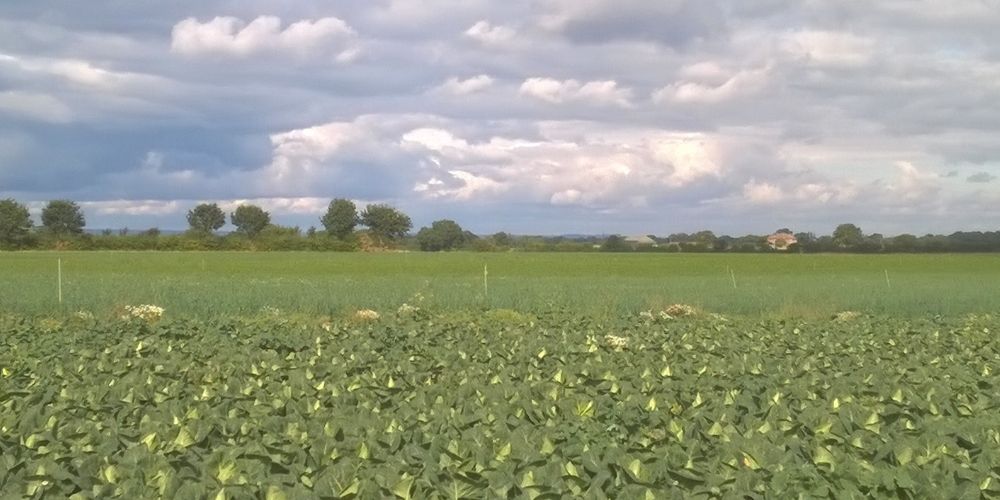Following his recent publication ‘Associational resistance through intercropping reduces yield losses to soil-borne pests and diseases’, IGDC Member Kelly Redeker shares this blog with us around the potential benefits of ‘intercropping’ for sustainable agriculture.
Agriculture faces significant challenges due to the projected increase in global population, changes in rainfall and temperature patterns, and increased pest and disease incidence caused by future climate changes. While intensive monoculture agricultural practices have been very effective for decades, new approaches are needed to provide sustainable, long term agricultural production. Sustainability includes, in the context of our work, improving individual field yields, returning carbon and nutrients to the soil to enhance soil health in intensively managed regions, and reducing pesticide use. And all of this to be accomplished at affordable, farmer-friendly costs.

The challenge of below ground pests and diseases
Our research group (including Chadfield, Hartley, Redeker) were particularly interested in reducing pesticide application. There are notable, and well publicized, ecological impacts that arise from pesticide use (e.g. bee population declines), not to mention reduced effectiveness over time due to the development of resistance in pest populations. Soils are home to a number of invertebrate pests, of which nematodes (or roundworms, a group of plant-parasitic organisms) are one of the most damaging to agriculture globally. The pesticide situation is even worse in soils, where available remaining nematicides are limited and tend to be indiscriminate toxicants. Finding effective, plant-based solutions to pest control would provide an important tool for sustainable long-term options for farmers.
Natural defence mechanisms – Associational resistance and intercropping
Plants have evolved a number of defence mechanisms, from directly damaging herbivores and pests (e.g. thorns), to moderating the local soil conditions (e.g. drying out the local soil), to indirectly influencing neighbouring plants (e.g. sending out chemicals that exist primarily as vapours, or gaseous, “warning signals”), to emitting gaseous compounds that attract predators to prey on offending herbivores. Together and within a community, these processes are described as “associational resistance”, or the provision of resistance within a plant community based on proximity and diversity. Intercropping, also known as companion planting in gardening, is a common practice in the global south, which has used these plant defence tools for decades in agriculture. However, their uptake in intensively managed (high fertilizer input, irrigated, monoculture) agricultural systems has been limited. A particular stumbling block to the development of these technologies is the broad range of published outcomes.
Does intercropping work?
We felt that the complexity of agricultural soil-plant systems was responsible for the varied outcomes reported. To better understand whether intercropping is a viable strategy for sustainable farming we performed a meta-analysis of the available, published literature. To be included, studies needed to have paired monoculture fields with intercropped fields. Over 300 studies were included, covering 45 main crops and over 20 intercropping plants. We found that both disease and nematode damage were reduced, on average, by 55 and 40%, respectively when intercropping was used as a strategy. In nematode infested fields, the yield of the intercropped primary crop was better than monoculture, even if the damage to the plants increased by 15%!
Since one of the main challenges to using intercropping more broadly is the number of different factors that come to play in agricultural systems we explored which field variables were most important. Our meta-analysis demonstrated that the primary drivers of intercropping success were limited in number. In both cases, pests and disease, the intercropping plant family was the most important, farmer-controlled, variable. To reduce nematode impacts planting from the daisy (Asteraceae), sesame (Pedaliaceae), or nightshade (Solanaceae) families was most effective, as was planting in unfertilized fields. Disease impacts were reduced by planting within the Amaryllidaceae family. Maintaining the planting density of the main crop when intercropping also improved disease control, which should increase acceptability to farmers looking to protect yields.
There are many ways in which an intercrop plant can deter pests and diseases. Their root exudates can act as direct killing compounds or reducing pest fitness. Gaseous emissions from roots can act as attractants or repellents. Or root compounds can modify hatching rates of pests, creating a mismatch between crop availability and early-stage feeding. It is clear from our results that more specific interactions between pest and intercrop plant leads to more effective control.
Future work
Our research group (inclusive of van Griethuysen, Redeker, Hartley, and Roy Nielson from James Hutton) have been exploring the interaction between plants, the tobacco rattle virus (TRV) and nematode vectors. TRV is a globally important potato crop disease that also affects beans, beets, peppers and ornamental bulb plants. Infected plants appear to produce a compound that is attractive to disease spreading nematodes. We intend to explore this interaction further, to study the range and efficacy of the attraction, and ultimately use this compound to lure nematodes away from crops in a pest-specific, sustainable manner.
About the author

In large, complicated systems sometimes small things can have outsized and/or unintended impacts. Kelly’s research engages in multidisciplinary approaches that develop and explore solutions to global developmental challenges (providing quantitative analytical methods when needed).

